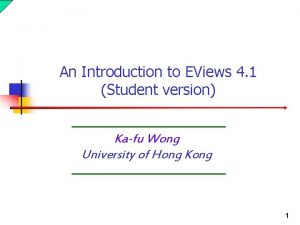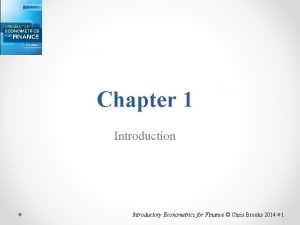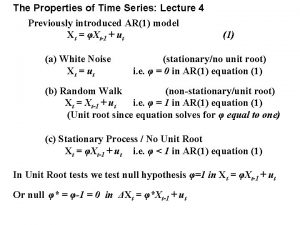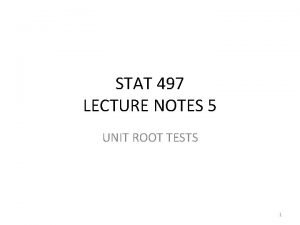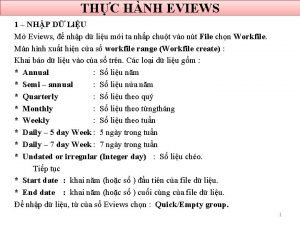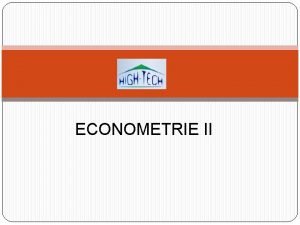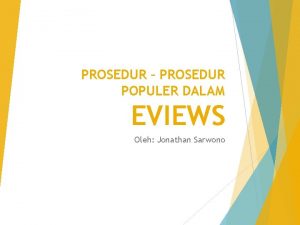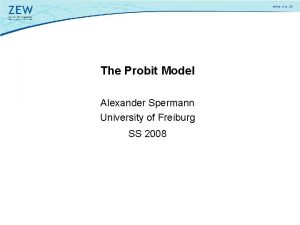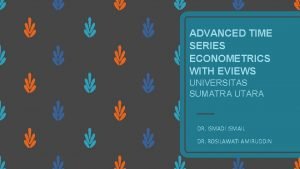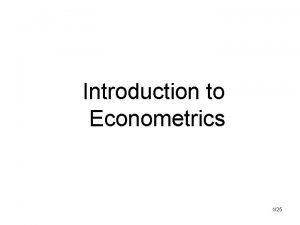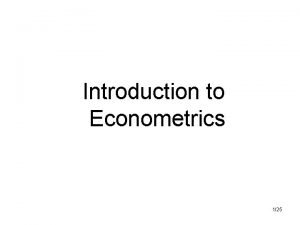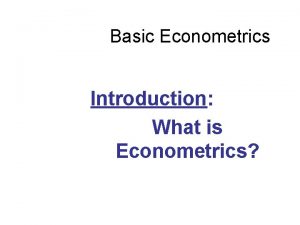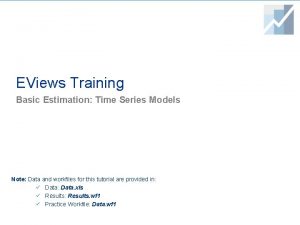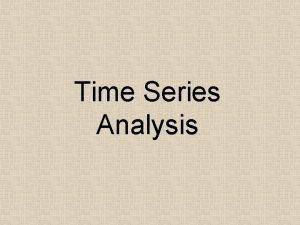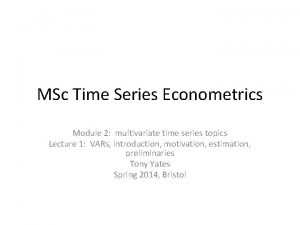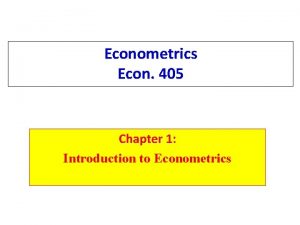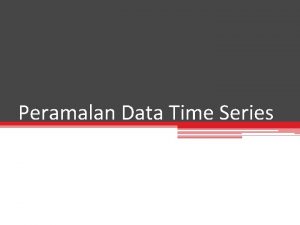Introduction to Time Series Econometrics with Eviews UNIT









![Main focus shifted towards univariate TS properties of U [UNIVARIATE APPROACH] Most of the Main focus shifted towards univariate TS properties of U [UNIVARIATE APPROACH] Most of the](https://slidetodoc.com/presentation_image_h2/07d0cdbbe8e9283141d5da0a6c2d8e6a/image-10.jpg)
![Univariate [Unit Root] Approach Univariate [Unit Root] Approach](https://slidetodoc.com/presentation_image_h2/07d0cdbbe8e9283141d5da0a6c2d8e6a/image-11.jpg)














- Slides: 25

Introduction to Time Series Econometrics with Eviews * UNIT ROOT Tests * [Mainly compiled from GP]

TS Data 2

Note: A random or stochastic process is a collection of random variables ordered in time. 3

4

RW 5

6

7

EXAMPLE from Towards a More Realistic Time Series Analysis of Unemployment Dynamics: Dynamics the Dual Adjustment Approach* By M. İsmihan * Paper presented to the Fourth Nordic Post-Keynesian Conference-Economics at the Edge", 20 th - 21 st of April 2017, Aalborg University, Aalborg, Denmark. 8

Natural Rate vs. Hysteresis H. • Hysteresis (in economics) generally • Milton Friedman “argued” that there ‘used to mean that, “after a shock, a is a unique natural rate of variable does not return to its initial unemployment which is consistent value, even when the shock has gone with price stability. away”. ’ BUT there are different • Natural Rate is determined as “the definitions (Setterfield, 2010) level ground out by the Walrasian • Accr. to Blanchard and Summers (1988) : system of general equilibrium “What is required is a theory of equations. . . including market unemployment in which unemployment, imperfections. . . the cost of gathering far from returning to a stable information about job vacancies and equilibrium -or "natural rate"- over time, labor availabilities, the costs of is instead strongly dependent on mobility, and so on” (Friedman 1968) history. We refer to such an equilibrium [ “Similar” arguments from Edmund as a "fragile equilibrium, " to highlight Phelps] the sensitive dependence of unemployment on current and past They earned Nobel Prize events. ” “FIXED” or ahistorical EQUILIBRIUM HISTORY -DEPENDENT EQUILIBRIUM
![Main focus shifted towards univariate TS properties of U UNIVARIATE APPROACH Most of the Main focus shifted towards univariate TS properties of U [UNIVARIATE APPROACH] Most of the](https://slidetodoc.com/presentation_image_h2/07d0cdbbe8e9283141d5da0a6c2d8e6a/image-10.jpg)
Main focus shifted towards univariate TS properties of U [UNIVARIATE APPROACH] Most of the empirical studies in the existing literature have focused on the univariate time series properties of the unemployment rate. While the presence of unit roots in the unemployment rate series are considered to be evidence in favour of the hysteresis hypothesis, its rejection (i. e. stationarity of unemployment rate) is taken as a validation of the unique natural unemployment rate.
![Univariate Unit Root Approach Univariate [Unit Root] Approach](https://slidetodoc.com/presentation_image_h2/07d0cdbbe8e9283141d5da0a6c2d8e6a/image-11.jpg)
Univariate [Unit Root] Approach

Does unemployment rate have a unit root ? Ut = 1. 60 + 0. 97 Ut-1 - 0. 25 Ut-2 Yes/No! 1%/5% Dickey Fuller

Does unemployment rate have a unit root ? Answer is usually “yes” for many countries

Univariate Approach (G 6 – evidence)

Stochastic Vs Deterministic Trends 15

I (d) 16

17

18

19

DF Tests: Alt. Spec. 20

LGDP: DF Tests 21

22

23

LGDP: ADF Tests 24

25
 Introduction to eviews
Introduction to eviews Introduction to eviews
Introduction to eviews Eviews student
Eviews student Introduction to econometrics for finance
Introduction to econometrics for finance Unit root time series
Unit root time series Unit root test lecture notes
Unit root test lecture notes For minutes. start.
For minutes. start. @recode eviews
@recode eviews Normality test
Normality test Eviews training
Eviews training Eviews programming language
Eviews programming language Ma trận hiệp phương sai trong eview
Ma trận hiệp phương sai trong eview Panel veri analizi örnekleri
Panel veri analizi örnekleri Eviews training
Eviews training Multicolinéarité
Multicolinéarité Stepwise regression eviews
Stepwise regression eviews Maclaurin series vs taylor series
Maclaurin series vs taylor series Heisenberg 1925 paper
Heisenberg 1925 paper Maclaurin expansion
Maclaurin expansion Taylor series lesson
Taylor series lesson Ibm p series models
Ibm p series models Series-series feedback amplifier examples
Series-series feedback amplifier examples Series aiding and series opposing
Series aiding and series opposing Sum of infinite series
Sum of infinite series Unit 10, unit 10 review tests, unit 10 general test
Unit 10, unit 10 review tests, unit 10 general test Probit model
Probit model


